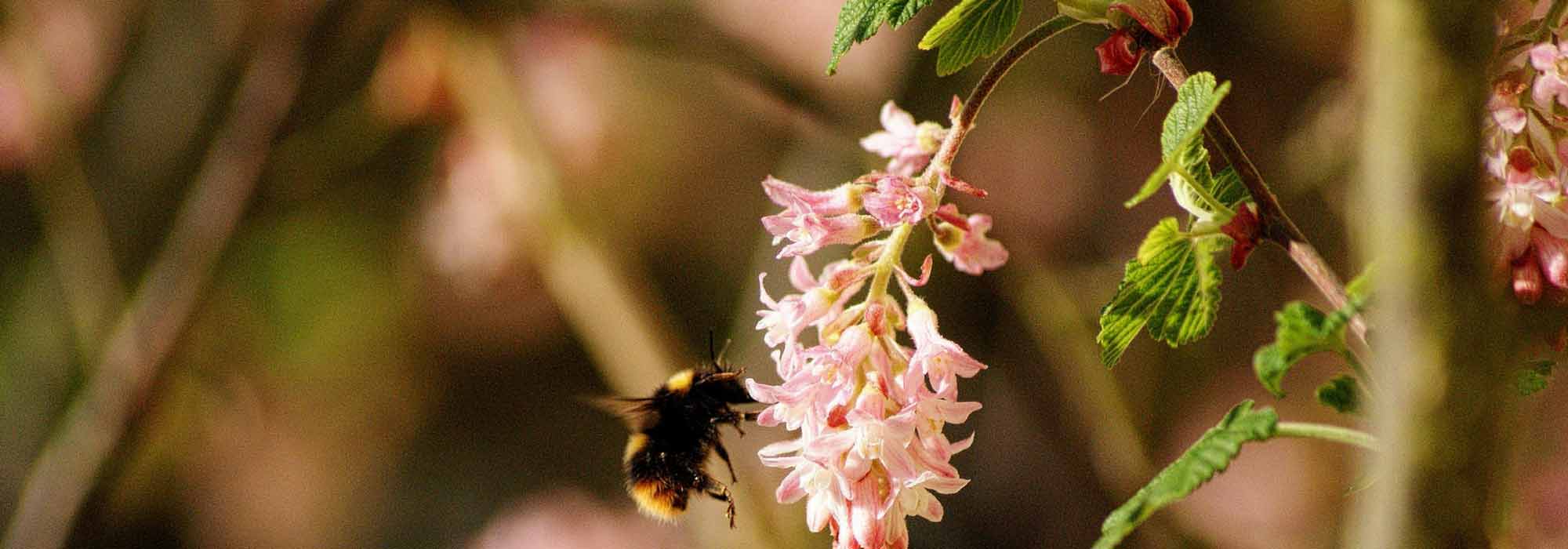
Flowering currant, Ribes: planting, pruning and maintenance
Contents
The Flowering Currant in a nutshell
- Flowering currant is an early and abundant flowering bush
- It has a graceful habit and a rustic appearance
- Hardy, it is easy to grow in ordinary soil
- Compact and floriferous, it is suitable for all gardens
- It can be used in a bocage or flowering hedge, in borders, but also in pots
A word from our expert
Flowering currant, also known as “False blackcurrant” or “Blackcurrant flower”, is a small ornamental bush highly valued for its spring flowering with a light fruity scent that appears on the newly leafed branches at the beginning of spring. Whether it is yellow, pink, white, or red flowering currant, it heralds the arrival of fine days.
Very early, it boasts a lovely deciduous and aromatic leafage of unparalleled elegance.
Hardy down to -25°C, the flowering currant or Ribes, which is quite resistant to diseases, is easy to cultivate in full sun or partial shade, in any cool soil that is not too dry.
The ornamental currant works wonders in a free or bocage hedge, in a shrub border, and can also be paired with spring bulbs. It adapts well to pot cultivation for the terrace.
With its graphic branches dotted with small flowers still in bud, it is also appreciated for making bouquets as winter comes to an end.
Discover our many varieties of flowering currants and adopt this essential bush for spring scenes without delay!
Description and Botany
Botanical data
- Latin name Ribes sanguineum
- Family Grossulariaceae
- Common name Flowering currant, Blood currant, false blackcurrant
- Flowering March to May
- Height 1.5 to 5 m
- Exposure Sun, partial shade
- Soil type All
- Hardiness -15°C to -20°C depending on varieties
The flowering currant or false blackcurrant is a ornamental shrub belonging to the Grossulariaceae family, which includes currants and blackcurrants, cultivated for their edible berries, hence its resemblance to its fruit-bearing cousins.
The genus Ribes comprises about 150 species of shrubs, mostly deciduous, rarely evergreen, sometimes thorny, and commonly found in forests and on rocky, wooded slopes in temperate regions of the Northern Hemisphere, particularly the north-west coasts of the United States.
Ribes sanguineum is the most commonly cultivated species in our gardens, available in many interesting cultivars such as ‘King Edward VII’. Other species of Ribes available commercially include Ribes gordonianum, known as Gordon’s currant, and its hybrid Ribes x gordonianum, still rare in our gardens, Ribes odoratum, the Chinese Ribes laurifolium, and the Californian Ribes speciosum and Ribes viburnifolium.
With a rapid growth rate, the flowering currant quickly forms a bushy clump that is highly branched from the base, dense and rounded. More or less spreading, it can reach up to 3 m in height. The branches of the flowering currant, rarely armed with thorns, rise up and arch gracefully at their tips. In Ribes sanguineum, the branches are a deep mahogany brown that darkens over the years.
The bright, deciduous foliage appears in early spring, just after the flowering begins. Aromatic, it releases a delightful scent reminiscent of blackcurrant when crushed, hence its name “false blackcurrant.”
It consists of rough, long-petiolate leaves measuring 3 to 10 cm long, oval to rounded, divided into 3 to 5 dentate lobes that resemble clover leaves.
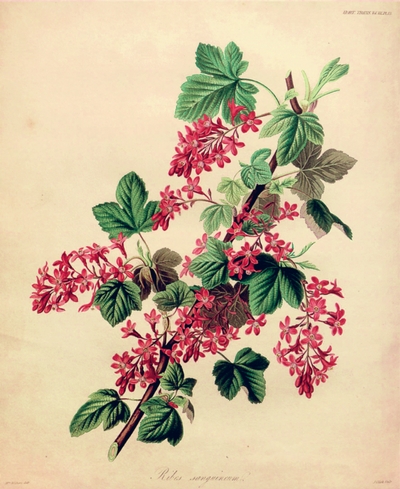
Flowering currant, botanical plate
In Ribes sanguineum, sometimes referred to as flower-cassis, the leaves are slightly downy on the underside. Dark green to light green, the foliage of some flowering currants takes on yellow-copper or red-purple hues in autumn before falling.
From the end of winter, as the leaves begin to unfurl, the flowering currant is remarkable for its graceful and abundant early flowering on branches that are still almost bare. From March to May, depending on the climate, a myriad of small tubular flowers with prominent stamens, composed of five petals, appear in compact, pendulous clusters measuring 2 to 10 cm long.
Most often carmine pink, they can also be yellow (Ribes alpinum), pure white in Ribes ‘White Icicle’, still too rare, or bright red with peach and cream streaks in Ribes gordonianum.
The branches with barely opened flowers will make beautiful spring bouquets or graphic compositions of ikebana, these Japanese bouquets with clean shapes.
Nectariferous, this fragrant flowering exudes a fruity scent of blackcurrant or carnation.
It is sometimes followed, from summer to autumn, by small blue-black, waxy berries, edible but tasteless, only appreciated by birds. Ribes x gordonianum does not produce fruit.
The flowering currant demonstrates great hardiness, easily withstanding temperatures down to -25 °C. It thrives in partial shade or in non-burning sun, in ordinary, deep soil, not too calcareous, rich and well-drained, remaining cool in summer.
It finds its place in all gardens, in a free hedge, in a shrub bed, or even as a solitary plant associated with bulbs or spring biennials. It also adapts well to pot culture for the terrace.

From left to right: Ribes sanguineum – R. ‘White Icicle’ – R. gordonianum – R. sanguineum ‘King Edward VII’
Read also
How to prune early flowering bushesSpecies and main varieties
If the genus Ribes includes more than 150 species, only a few are marketed. Ribes sanguineum, the flowering redcurrant, is the most commonly cultivated species in our gardens. It is available in numerous cultivars that have expanded the range of colours from the pure white ‘White Icicle’ to the crimson rose-red ‘King Edward VII’.
The most popular
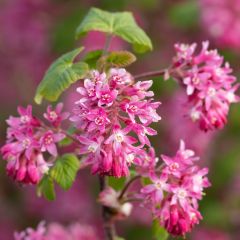
Ribes sanguineum - Flowering Currant
- Flowering time April, May
- Height at maturity 3 m
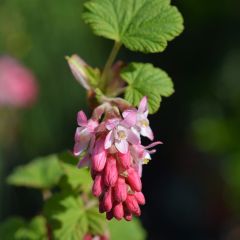
Ribes sanguineum King Edward VII - Flowering Currant
- Flowering time April, May
- Height at maturity 2 m
Our favourites
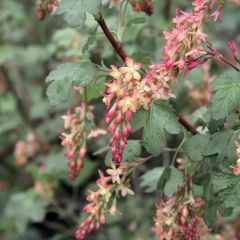
Ribes gordonianum - Gordon's Currant
- Flowering time May, June
- Height at maturity 1,80 m

Ribes sanguineum White Icicle - Flowering Currant
- Flowering time April, May
- Height at maturity 2,50 m
Discover other Ribes - Flowering Currants
View all →Available in 1 sizes
Available in 2 sizes
Available in 2 sizes
Available in 2 sizes
Available in 1 sizes
Available in 1 sizes
Available in 1 sizes
Available in 1 sizes
Available in 1 sizes
Available in 1 sizes
Young plantation
Where to plant flowering currant?
Flowering currant can be planted all over France, except perhaps in Mediterranean climates, which are a bit too hot and dry in summer. With good hardiness, it can easily withstand very low temperatures down to -25 °C, ensuring a perfect resistance in all regions.
It should be planted sheltered from winds, in the sun where it flowers better, but in a non-scorching exposure, especially in hot regions where it will appreciate light shade.
Not very demanding, it is content with any good garden soil, fresh and not too calcareous, as long as it is well-drained since it fears winter moisture. It prefers a fairly rich soil that remains cool in summer: a humus-bearing and cool soil prevents the drying out of the branches. Once established, it will cope well with drought, especially in deep soil.
In the background of a perennial bed or in a grove of spring-flowering shrubs, planted alone, in a flowering hedge or in a pot on the terrace, flowering currant is unobtrusive and adapts to all gardens.
Planted in groups of 3 or 5, flowering currant is perfectly suited for cultivation in a landscape or country hedge, forming an elegant fragrant floral screen.
When to plant a ribes?
The planting of flowering currant is preferably done in autumn in September-October, to encourage rooting before winter, avoiding periods of heavy frost.
How to plant flowering currants?
In open ground
In a hedge, maintain a spacing of at least 80 cm to 1 m between each plant.
- Soak the root ball in a bucket of water
- Remove stones, roots, and weeds from the soil
- Loosen the soil well
- Gently tease apart the root ball
- Dig a hole three times the volume of the root ball
- Add a good layer of pumice, river sand, or gravel at the bottom of the hole
- Enrich with well-matured compost
- Plant the bush at collar level in the centre of the hole
- Backfill the hole while keeping the bush upright
- Firm the soil well around the base of the plant
- Mulch to keep the base clean and cool during summer
- Water generously at planting and then once a week during growth in the first year
Pot cultivation
Choose a wide and deep container of at least 50 cm in diameter. Repot every 2 or 3 years in autumn.
- Drain the bottom with a layer of about twenty centimetres of clay balls
- Use a good potting soil, or a mixture of equal parts universal potting soil and garden soil
Maintenance and care
Easy to grow, flowering currant requires little maintenance. While this bush adapts easily to all types of soils, it prefers cool soils that are not too dry. In summer, water once or twice a week during hot spells. To keep the base cool during the warm season, apply a good layer of organic mulch before spring, especially in the first few years after planting; afterwards, it will be more resistant to drought.
Additions of well-matured compost or organic fertiliser in autumn improve its growth.
Potted flowering currants require more regular watering: keep the soil cool but not overly wet throughout the warm season. Fertilise with a liquid fertiliser once a month during the entire growth period. In winter, limit watering.
How to prune a flowering currant?
The pruning of the flowering currant is not necessary, except to rebalance the habit, remove dead wood, aerate the branches, or correct a somewhat sparse habit. There is no need to prune every year. Pruning should be carried out immediately after flowering.
Maintenance Pruning:
Every year, on young plants, remove weak shoots, spindly branches, and dead wood from older bushes.
Renewal Pruning:
On a plant older than three years that is becoming bare, prune one-third of the branches every two years to encourage the formation of young stems.
You can also carry out a hard pruning every 4-5 years, cutting back the oldest branches to 50 cm above the ground, to rejuvenate the bush and encourage it to produce new shoots.
→ Learn more about pruning flowering currants in our tutorial!
Diseases and potential pests
Cultivated under good conditions, the flowering currant is very resistant to diseases and pests. However, it can be affected by rust, which covers the foliage with orange pustules, and powdery mildew, which whitens, dries out, and causes leaves to fall prematurely: spray a solution of comfrey manure and/or a solution based on nettle infusion or garlic decoction.
In hot and dry weather, red spider mites can devour its foliage; the leaves then become greyish and eventually fall off. Make soap water sprays or shower the foliage with cold water at the end of the day.
Multiplication: How to propagate a flowering currant?
Flowering currant is easily propagated by semi-woody cuttings in August-September or woody cuttings taken in December. It tends to layer naturally: take these rooted shoots and replant them immediately in the chosen location.
By semi-woody cuttings
- At the end of summer, take a cutting just below an eye, the thin tip of a semi-ripe shoot from the year, measuring 10 to 15 cm (that is, in the process of transitioning from softwood to hardwood)
- Make a lengthwise incision in the bark for 5 cm
- Remove the leaves from the lower third
- Plant them about 7 cm deep in a well-draining mix of sand and potting soil
- Keep the substrate moist until rooting under a cold frame
- Transplant your cuttings into pots the following spring
- Allow the young plants to harden off in individual pots for at least a year before their final planting in the garden
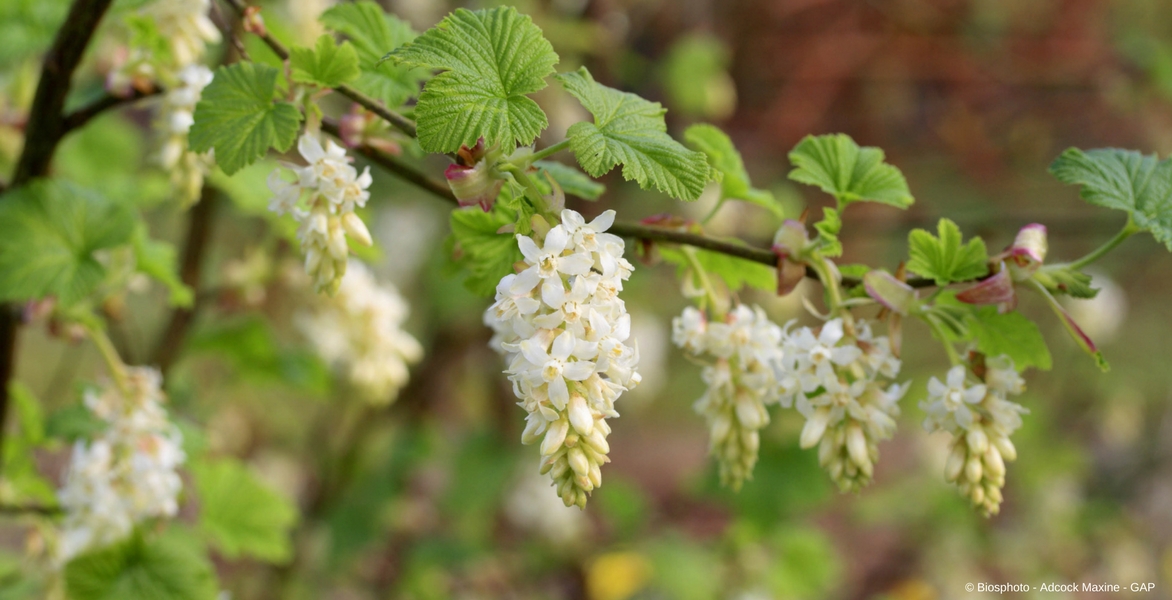
Ribes sanguineum ‘White Icicle’
Associate
Highly prized for its abundant and bright flowering that begins in early spring, the Flowering Currant thrives in all natural and country gardens for wonderfully spring-like or romantic scenes. It pairs well with a multitude of perennial plants, bulbs, and early-flowering bushes.
Planted in groups of three or four, it can be combined with other varieties of Ribes or other flowering hedge shrubs, such as lilacs, a ‘Hollandia’ broom, a Syringa microphylla ‘Superba’, a Kerria japonica, or a Prunus persica Taoflora Pink.
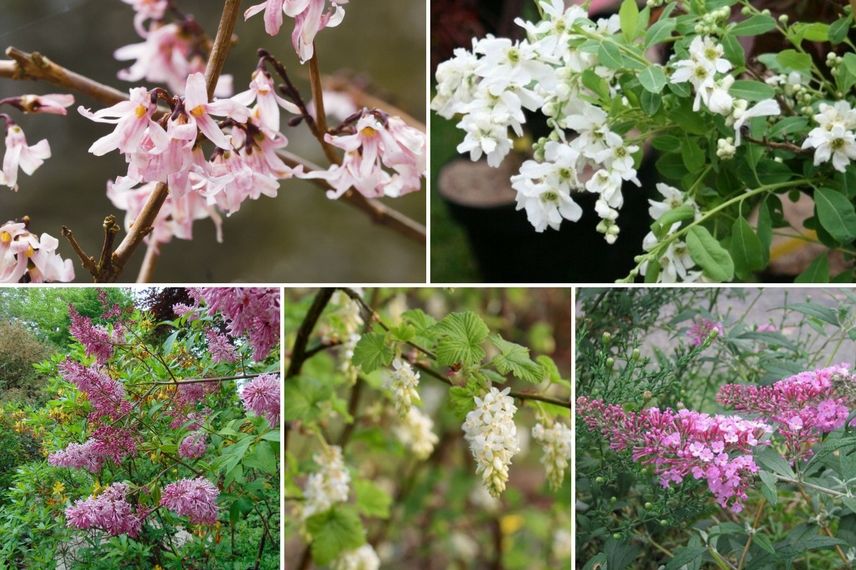
An example of a very “girly” hedge combination for a flowering display from February to September: Abeliophyllum distichum ‘Roseum’ – Exochorda macrantha ‘The Bride’ – Syringa microphylla ‘Superba’ – Ribes sanguineum ‘White Icicle’ – Buddleia davidii ‘Pink Delight’
The bright pink flowering of Ribes ‘King Edward VII’ accompanies that of forsythias, an Abeliophyllum distichum ‘Roseum’, and Japanese quinces.
It pairs beautifully with spring bulbs such as daffodils, muscari, and tulips.
The Flowering Currant harmonises well with purple-leaved perennials like bugle and borage or purple-flowering plants, vinca minor, Symphytum officinale.
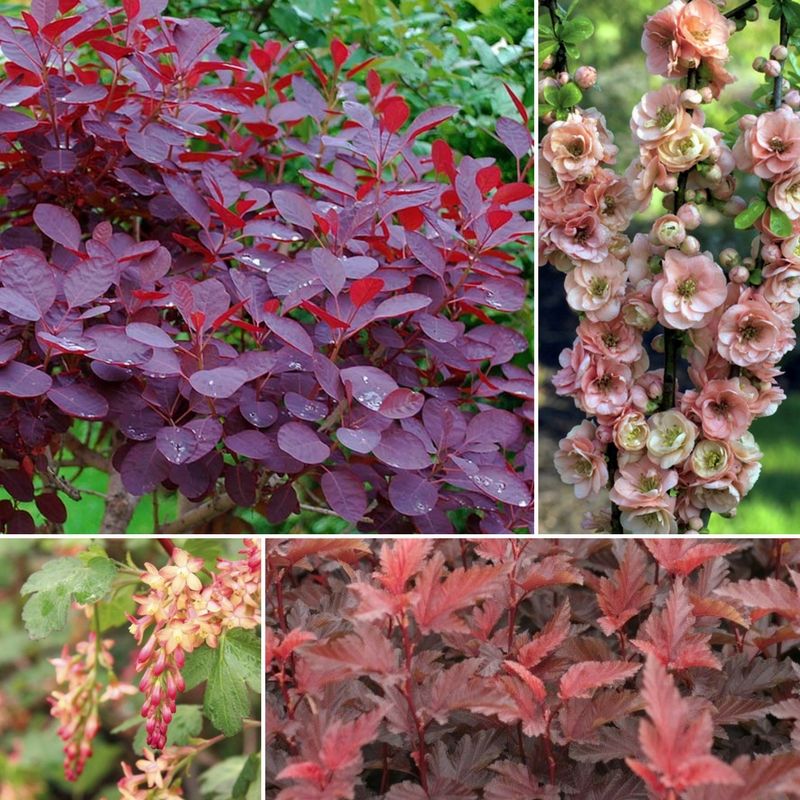
An example of a purple and salmon hedge combination: Cotinus coggygria ‘Royal Purple’ – Chaenomeles superba ‘Cameo’ – Ribes gordonianum – Physocarpus opulifolius ‘Lady in Red’.
Rather insignificant by the end of spring, consider surrounding it with companions that will take over its flowering, such as buddleias, the Mexican Orange, or an Exochorda macrantha ‘The Bride’. It will gladly welcome the rest of the season, a honeysuckle or a summer-flowering clematis.
Useful resources
- Discover the most beautiful currant bushes, some of which are exclusive!
- Find our 5 ideas for pairing Flowering Currant
Frequently asked questions
-
I have a flowering currant in my garden, its leaves are turning yellow, is it a disease?
If the leaves of the flowering currant are discolouring and turning yellow while the veins remain green, your bush is likely showing signs of excess lime in the soil. Add heather soil by scratching it into the ground around its base to restore the pH.
- Subscribe!
- Contents

































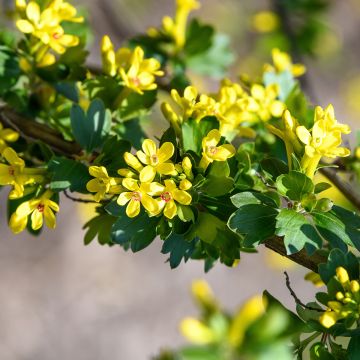

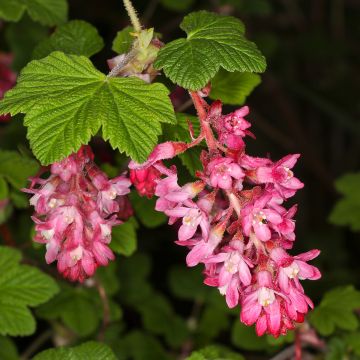
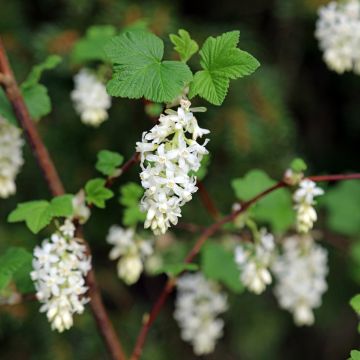
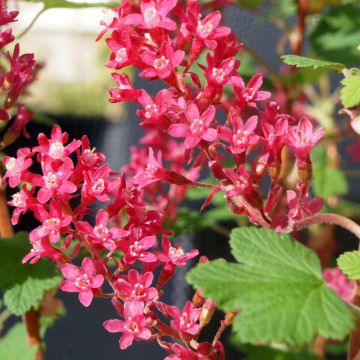
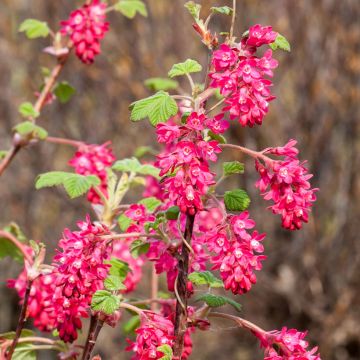
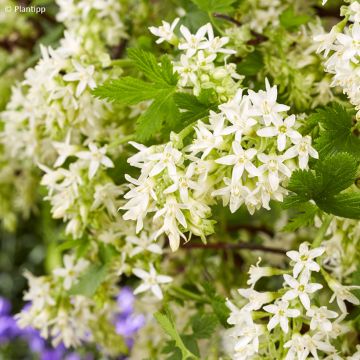
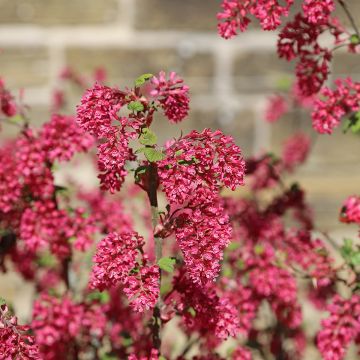
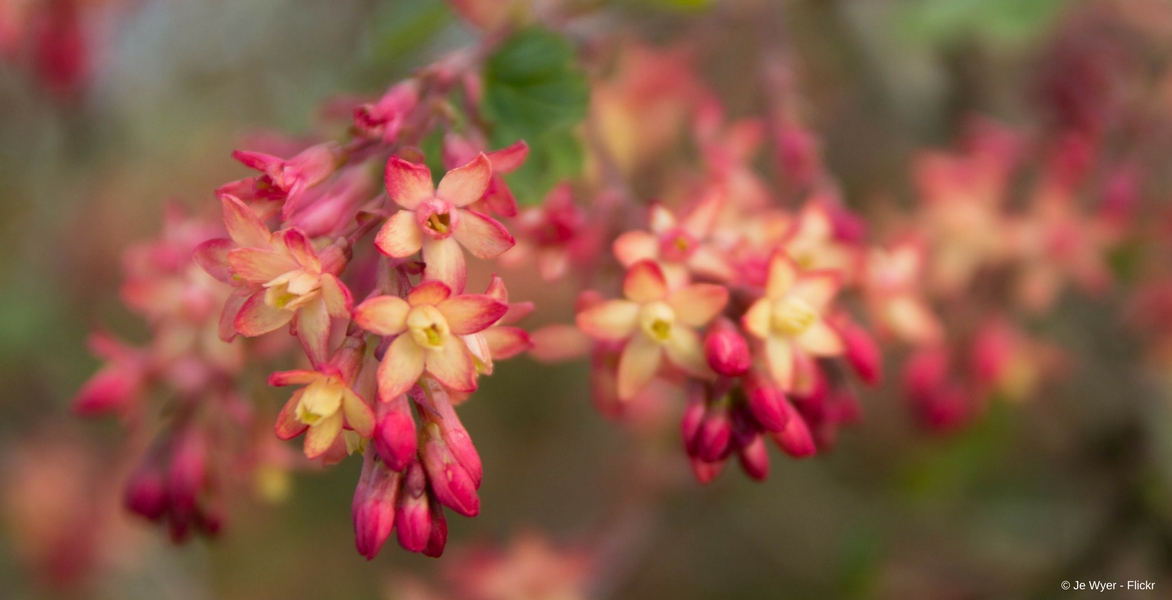
Comments